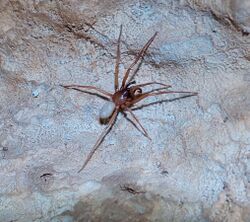Biology:Stalita taenaria
| Stalita taenaria | |
|---|---|

| |
| Stalita taenaria, cave in Slovenian Karst | |
| Scientific classification | |
| Domain: | Eukaryota |
| Kingdom: | Animalia |
| Phylum: | Arthropoda |
| Subphylum: | Chelicerata |
| Class: | Arachnida |
| Order: | Araneae |
| Infraorder: | Araneomorphae |
| Family: | Dysderidae |
| Genus: | Stalita |
| Species: | S. taenaria
|
| Binomial name | |
| Stalita taenaria Schiodte, 1847[1]
| |
| Synonyms[1] | |
| |
Stalita taenaria is an araneomorph spider species in the family Dysderidae.[2] The species is classified as a member of troglofauna, more precisely a troglobiont species, meaning such spiders are obligate cave-dwellers adapted to living in dark surroundings.[3][4] Stalita taenaria is a species of a few European countries.[5] The spider is thought to be the first described species of true (eyeless[6]) cave spider in the world.[7][8]
Taxonomy
The species was first described and named by Danish entomologist Jørgen Matthias Christian Schiødte in 1847.[9] In the same year Schiødte also named and described the genus Stalita,[10] while making Stalita taenaria its type species.[11] Besides S. taenaria there are three more species in the same genus.[12]
Description
Males
Males of this species are approximately 6.7 millimetres long. They have densely haired and oval opisthosoma (abdomen) which is of bright ivory colour. Their legs are reddish-brown and covered with many characteristic spines which are located only on a spider's tibial and femoral part of a leg. A spider has a flattened prosoma (cephalothorax) of dark rusty-brown colour. Bulbs of their pedipalps are quite long and shaped nearly cylindrical; they end with many long teeth. A peak of the embolus is claw-shaped.[5]
Females
Females of this species are a bit bigger, usually reaching from 7 to 9 millimetres of length, with their prosoma reaching from 3.2 to 3.7 millimetres. A female's mouth parts, the chelicerae, consist of a promargin with three and retromargin containing only one teeth. A characteristic of females is also a vulva, which has T-shaped anterior part.[5]
Distribution
Stalita taenaria is a relatively rare European troglobite species, limited to countries of Slovenia, Italy and Croatia.[5]
Gallery
References
- ↑ 1.0 1.1 "Stalita taenaria Schiödte, 1847" (in en). https://www.gbif.org/species/2139180.
- ↑ Bern, Natural History Museum. "NMBE - World Spider Catalog - Stalita taenaria" (in en). https://wsc.nmbe.ch/species/10182.
- ↑ "Jamarski leksikon" (in sl). https://www.jamarska-zveza.si/index.php/o-nas/jamarski-leksikon.
- ↑ Pipan T., Pečnik M., Drole F., Kozel P. Inventarizacija jamske favne na Kočevskem - Poročilo o rezultatih raziskave pred sanacijskim čiščenjem jam (2016). Retrieved 24.10.2021 (in Slovenian).
- ↑ 5.0 5.1 5.2 5.3 "Araneae (Spiders of Europe) - Stalita taenaria Schiödte, 1847" (in en). https://araneae.nmbe.ch/data/1169.
- ↑ Mammola, Stefano; Isaia, Marco (2017-04-26). "Spiders in caves". Proceedings of the Royal Society B: Biological Sciences 284 (1853): 20170193. doi:10.1098/rspb.2017.0193. ISSN 0962-8452. PMID 28446696.
- ↑ Pavlek, Martina; Arnedo, Miquel; Gasparo, Fulvio; Adrian, Silvia (2018). "Unraveling the evolutionary history of the cave-dwelling Dysderidae in the Dinarides" (in English). ARPHA Conference Abstracts 1. doi:10.3897/aca.1.e29975. https://aca.pensoft.net/article/29975/.
- ↑ Ramšak, Lucija (2007). "Vpliv turizma na kopensko favno Postojnske in Otoške jame : diplomsko delo" (in sl). https://repozitorij.uni-lj.si/IzpisGradiva.php?id=37243.
- ↑ "ITIS - Report: Stalita taenaria". https://www.itis.gov/servlet/SingleRpt/SingleRpt?search_topic=TSN&search_value=867419#null.
- ↑ "ITIS - Report: Stalita". https://www.itis.gov/servlet/SingleRpt/SingleRpt?search_topic=TSN&search_value=849415#null.
- ↑ "World Spider Catalog- Stalita". http://research.amnh.org/oonopidae/catalog/references.php?id=42491.
- ↑ "NMBE - World Spider Catalog - Stalita". https://wsc.nmbe.ch/genus/843.
Wikidata ☰ Q2406046 entry
 |



